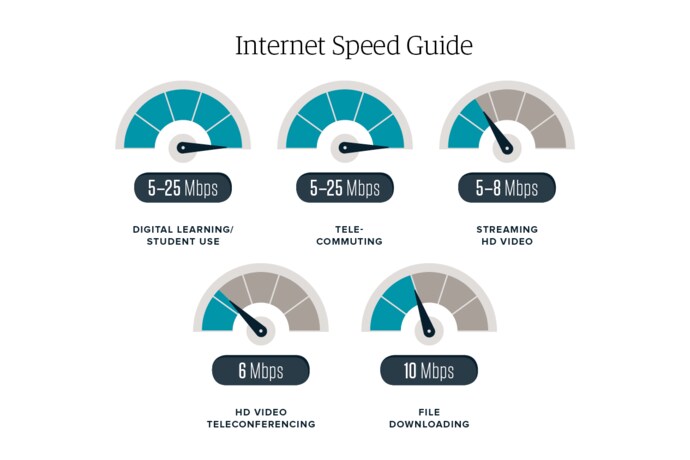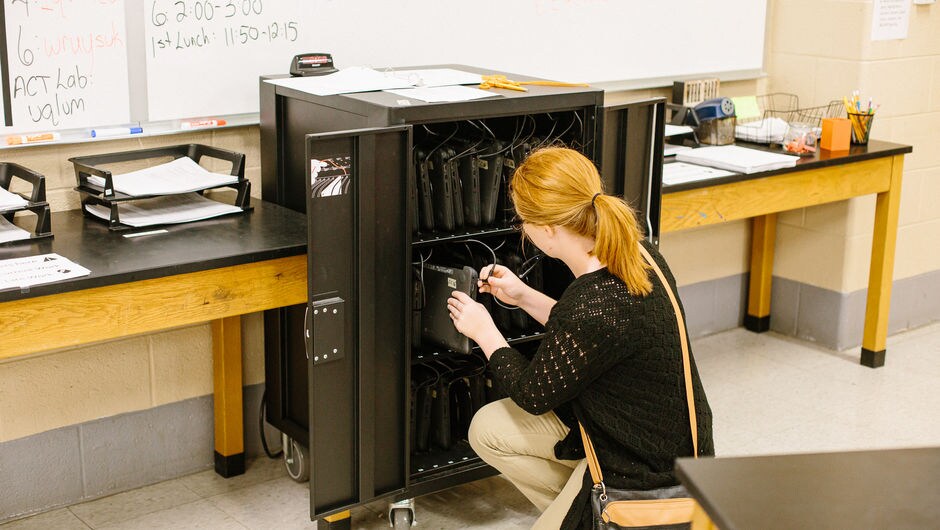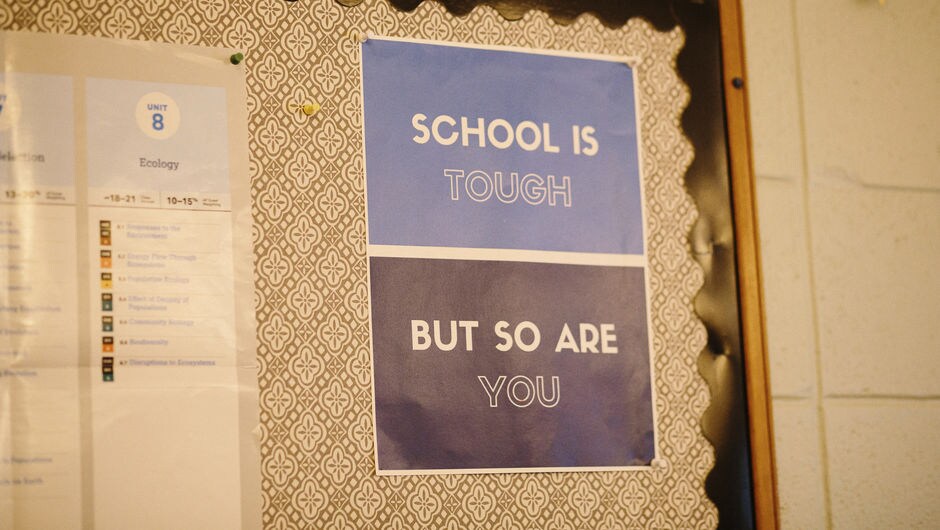
How Rural Students Are Left Behind in the Digital Age
The rural broadband gap is one of the biggest educational obstacles for rural communities, and it has consequences for students and teachers alike.
At Leslie County High School, an expansive brick building backdropped by the rolling hills of Eastern Kentucky, Lydia Weiso’s AP English students were deep in discussion about their strategies for getting work done online.
Jaden travels to the school where his mom works to upload files for his college credit work. Jasmine goes up on the mountain near her house. Above the trees, she gets the clear cell service she needs to do her homework.
Other students chimed in with their own tried-and-true methods of getting online in Leslie County: mobile hotspots, the Wi-Fi at Subway, or visiting friends who live on the edges of the county and receive fast cable internet access—all in order to do homework or spend time doing what teens love best, playing online video games and uploading songs to SoundCloud.
Without access to high-speed broadband internet at home, students like Jaden and Jasmine—not to mention teachers like Lydia—are forced to find clever solutions like these to get their assignments done and stay connected. "As teachers, we're always looking for everyday workarounds,” says Lydia, who moved to Leslie County in 2018 to join Teach For America. “‘What can I just print and go? What can I alter? How can I show this video?”
This disparity, known as the rural broadband gap, is a reality for millions of students in rural communities across America. And despite being just as capable and ready to learn, rural students are falling behind their peers in the digital age due to lack of access to high-speed internet.

The Rural Broadband Gap
To be clear, this isn't just a problem in Eastern Kentucky. From the hollers of Appalachia to the great plains of South Dakota to the expansive deserts of the Southwest, access to high-speed internet can be sparse and expensive, or sometimes not even an option at all.
Teachers like Maria Villalpando Lopez in Texas' Rio Grande Valley face similar challenges to the ones faced by educators in Eastern Kentucky. Maria graduated from Juarez-Lincoln High School in Mission, Texas, and returned to the school as a teacher when she joined Teach For America in 2018. That makes her deeply familiar with the technological challenges kids face there, from the perspective of both a student and an educator. She estimates that less than half of her students have broadband at home. “When I was a student, the only time when we could apply to college was when we were in school,” Maria says. “We had to take time out of when we were in school to apply for college and do all those things at the computer lab.”
If internet access wasn’t a problem, Maria would bring much more digital learning into the classroom. “I would definitely do a lot of research and projects and extend Google Classroom to beyond just the classroom and have them use it at home,” Maria says.
“It is just so important for students to have access to the internet, especially in this day and age. It's important for homework. It's important for them to just expand their knowledge,” she adds. “Sometimes students are just curious and they want to Google something, and they can't do that at home because of poor internet coverage.”
Why High-Speed Internet Matters to Students
While there are still households without any internet connection whatsoever, many rural students do have some form of internet at home. So how is it that they’re unable to do homework despite having internet service? The problem lies in slow speeds and unreliable connections.
High-speed internet is delivered by cable or fiber wires; to be considered “true broadband,” it must be a minimum speed of 25 megabits per second download and 3 mbps upload, according to the Federal Communications Commission in 2019. By comparison, the average download speed in Hyden, the county seat of Leslie County, is 8.45 Mbps.
And, in many rural areas, the only internet options are DSL, satellite, or even dial-up. These internet access methods are often more costly, despite being less reliable and more easily affected by poor weather conditions. They can also be too slow to load and run the websites and software required for digital learning. This means that while it’s possible to read and write emails or check social media, students hoping to download a textbook or stream an HD video for class are out of luck.

Citation: https://www.fcc.gov/reports-research/guides/broadband-speed-guide
The Cost of Not Upgrading
For decades, rural communities have suffered from underinvestment. The costs of laying down cable and fiber in the expansive and often rugged terrain of many rural regions are often too prohibitive for communities struggling with economic hardship. Telecom companies also lack incentive to build out in low-population areas, contributing to this underinvestment.
As a result, expanding the infrastructure necessary to make high-speed internet an option in every rural household will cost multiple billions of dollars. But it will cost far more if things remain the same.
The rural broadband gap is one of the biggest educational obstacles for rural communities.
“Broadband internet has become as critical in the classroom as a textbook and as indispensable at home as a calculator,” Allen Pratt, the executive director for the National Rural Education Association, writes in an op-ed for The Hill. “Without broadband connectivity, kids living in rural areas are being prepared to compete in a 21st Century economy with 20th-century tools.”
The consequences of this are clear: Rural students without high-speed internet at home are scoring lower in reading, math, and science, according to a 2018 report by the National Center for Educational Statistics.
Some families rely solely on their smartphone data plans to accomplish tasks online. While some smartphone plans offer broadband speeds in the form of powerful wireless LTE, smartphone devices lack the tools necessary for telecommuting and school work, and are cumbersome to do research and write reports on.
Even though seven in 10 teachers assign homework that requires internet access, according to the FCC, it can be next to impossible for some rural students to do their homework or classroom projects at home.
Thirty-five percent of teenage students say they often or sometimes have to do their homework on their smartphones and 12 percent say they often or sometimes use public Wi-Fi in places like fast food restaurants and the public library to do their homework, according to 2018 Pew Research Center report on the broadband gap, which is also often referred to as the homework gap.

It often falls upon teachers to make tough choices. Do they assign digital homework that teaches skills their students will need to know for the 21st-century job market? Keep homework paper-based, so no students are left out due to their home circumstances? Or do they set aside blocks of classroom time for digital homework in an already crammed curriculum?
There are also more practical concerns, such as: What happens when the Wi-Fi is on the fritz during lessons or exams? Unreliable internet in school buildings can cause disruptions during online tests and even hold teachers back from integrating online activities into classwork.

Without a bold solution, this problem is only likely to become worse, with rural communities across America facing a “brain drain” crisis. Young adults grow up and move away from their homes to seek college and career opportunities elsewhere, often out of necessity. Local public school districts are losing funding and students as families move away to search for work elsewhere. And counties are losing out on new economic development opportunities because they can’t tap into the growing digital entrepreneur and remote work market.
The challenge is daunting, but these communities haven’t lost hope. Community leaders, educators, and elected officials alike are realizing that the revitalization of rural communities rests largely on broadband expansion and the opportunities that expansion will bring for future generations. That’s why many rural communities are taking a stand and developing their own fixes to the rural broadband gap.
In Leslie County, the local bank’s IT coordinator, Frank Baker, is leading a project he hopes may bring such a fix to his community. “Our youth, our future generations, it'll be hard for them to compete with others until we have the infrastructure that a lot of places take for granted,” Frank says.
That's why he has dedicated so much of his free time to narrowing the broadband gap for the town's students.
Sign up to receive articles like this in your inbox!
Thanks for signing up!
Content is loading...





